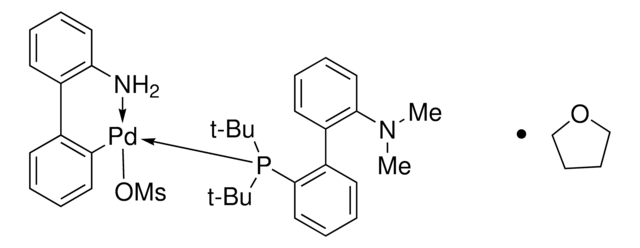695874
t-BuDavePhos
Synonim(y):
2′-(Di-tert-butylphosphino)-N,N-dimethylbiphenyl-2-amine, t-Butyl DavePhos, 2-Di-tert-butylphosphino-2′-(N,N-dimethylamino)biphenyl, tBuDavePhos
About This Item
Polecane produkty
Postać
solid
Poziom jakości
przydatność reakcji
reagent type: ligand
reaction type: Arylations
reagent type: ligand
reaction type: Buchwald-Hartwig Cross Coupling Reaction
reagent type: ligand
reaction type: C-X Bond Formation
mp
114-118 °C
grupa funkcyjna
phosphine
ciąg SMILES
CN(C)c1ccccc1-c2ccccc2P(C(C)(C)C)C(C)(C)C
InChI
1S/C22H32NP/c1-21(2,3)24(22(4,5)6)20-16-12-10-14-18(20)17-13-9-11-15-19(17)23(7)8/h9-16H,1-8H3
Klucz InChI
PHLPNEHPCYZBNZ-UHFFFAOYSA-N
Powiązane kategorie
Zastosowanie
Dialkylbiaryl phosphine ligand often used for Pd-catalyzed reactions in a range of contexts.
Hasło ostrzegawcze
Warning
Zwroty wskazujące rodzaj zagrożenia
Zwroty wskazujące środki ostrożności
Klasyfikacja zagrożeń
Aquatic Chronic 4 - Eye Irrit. 2 - Skin Irrit. 2 - STOT SE 3
Organy docelowe
Respiratory system
Kod klasy składowania
11 - Combustible Solids
Klasa zagrożenia wodnego (WGK)
WGK 3
Temperatura zapłonu (°F)
Not applicable
Temperatura zapłonu (°C)
Not applicable
Środki ochrony indywidualnej
dust mask type N95 (US), Eyeshields, Gloves
Certyfikaty analizy (CoA)
Poszukaj Certyfikaty analizy (CoA), wpisując numer partii/serii produktów. Numery serii i partii można znaleźć na etykiecie produktu po słowach „seria” lub „partia”.
Masz już ten produkt?
Dokumenty związane z niedawno zakupionymi produktami zostały zamieszczone w Bibliotece dokumentów.
Klienci oglądali również te produkty
Produkty
Buchwald phosphine ligands for C-C, C-N, and C-O bond formation.
Powiązane treści
The Buchwald group has developed a series of highly active and versatile palladium precatalysts and biarylphosphine ligands used in cross-coupling reactions for the formation of C-C, C–N, C–O, C–F, C–CF3, and C–S bonds. The ligands are electron-rich, and highly tunable to provide catalyst systems with a diverse scope, high stability and reactivity. Furthermore, the new series of precatalysts are air-, moisture and thermally-stable and display good solubility in common organic solvents. The use of precatalysts ensures the efficient generation of the active catalytic species and allows one to accurately adjust the ligand:palladium ratio. The ligands, precatalysts and methodology developed in the Buchwald group are user friendly and have rendered previously difficult cross couplings reactions, much easier to achieve.
Nasz zespół naukowców ma doświadczenie we wszystkich obszarach badań, w tym w naukach przyrodniczych, materiałoznawstwie, syntezie chemicznej, chromatografii, analityce i wielu innych dziedzinach.
Skontaktuj się z zespołem ds. pomocy technicznej

















